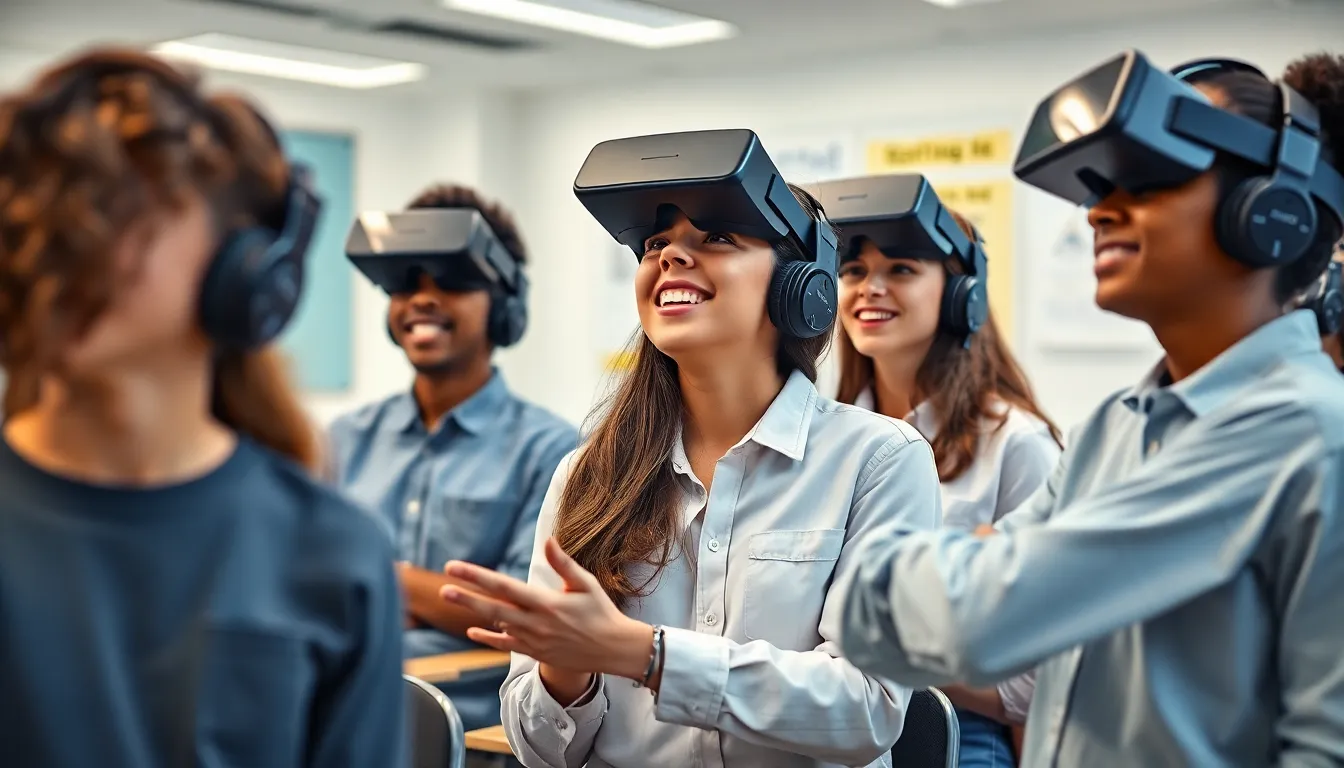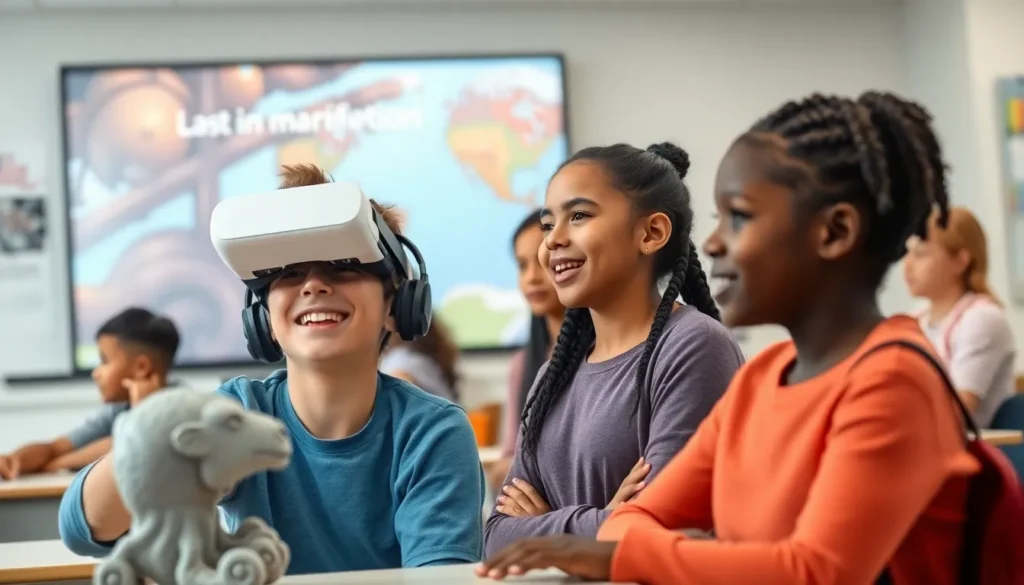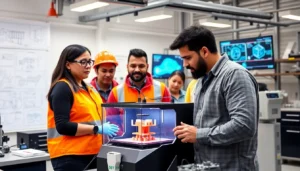Table of Contents
ToggleIn a world where learning is as fast-paced as a cat chasing a laser pointer, emerging learning technologies are revolutionizing how knowledge is shared and absorbed. From AI-powered tutors that never need coffee breaks to immersive virtual reality classrooms that make traditional lectures feel like watching paint dry, the future of education is here—and it’s dazzling.
Overview of Emerging Learning Technologies
Emerging learning technologies encompass tools that shape modern education landscapes. Artificial intelligence-powered tutors provide personalized learning experiences, adapting to individual student needs. Virtual reality classrooms create immersive environments, allowing learners to explore complex concepts through real-life simulations.
Mobile learning applications facilitate education on-the-go, enabling access to resources anytime and anywhere. Cloud-based platforms host collaborative learning spaces, fostering communication among students and instructors.
Gamification strategies enhance engagement by incorporating game-like elements into learning activities. Analytics tools gather data on student performance, helping educators identify areas that require improvement.
Educational technologies, like adaptive learning software, modify content based on student interactions. Augmented reality applications overlay digital information onto the physical world, enriching learning with interactive elements. Learning management systems streamline course administration, providing a centralized hub for resources and assessments.
Innovative technologies like blockchain offer secure credentialing systems, verifying academic achievements in a decentralized manner. 3D printing supports hands-on learning experiences in STEM subjects, allowing students to create tangible prototypes.
As these technologies progress, they democratize education, making it accessible regardless of location or socioeconomic status. Each advancement introduces new possibilities, illustrating the potential to transform traditional pedagogical approaches.
Key Trends in Learning Technologies

Emerging learning technologies are reshaping education, enhancing accessibility and engagement. Innovations such as artificial intelligence and virtual reality play significant roles in this transformation.
Artificial Intelligence in Education
AI is revolutionizing how educational content is delivered and personalized. Adaptive learning systems analyze student performance data to tailor lessons according to individual needs. AI-powered chatbots provide immediate assistance, enhancing student support outside traditional classroom hours. Furthermore, predictive analytics enables educators to identify at-risk students early, allowing for timely interventions. The incorporation of AI not only streamlines administrative tasks but also assists teachers in creating more effective learning environments.
Virtual and Augmented Reality Tools
Virtual and augmented reality technologies offer immersive learning experiences that engage students like never before. VR environments simulate real-world scenarios, providing practical training opportunities in fields such as healthcare and engineering. AR tools overlay digital information onto physical spaces, enhancing the understanding of complex concepts. These technologies foster collaborative learning by enabling students to work together in shared virtual settings, breaking down geographical barriers. By making education more interactive and engaging, VR and AR transform traditional learning methods into dynamic experiences.
Benefits of Emerging Learning Technologies
Emerging learning technologies offer substantial advantages that significantly enhance educational experiences. These innovations improve student outcomes and engagement through various means.
Enhanced Engagement and Interactivity
Interactive tools, such as gamified platforms and virtual reality environments, captivate students’ attention effectively. They stimulate interest, making learning enjoyable and immersive. Real-time collaboration features foster relationships among peers, creating a vibrant learning community. Students participate actively, resulting in better retention of concepts. Moreover, immediate feedback from digital resources allows learners to assess their understanding promptly. This active involvement transforms traditional classroom dynamics, encouraging creative thinking and problem-solving.
Customization and Personalization
Adaptive learning technologies tailor educational content to individual student needs. These systems analyze performance data to provide customized resources suitable for each learner’s pace. Personalized pathways enhance motivation, ultimately leading to improved academic success. AI-driven platforms also facilitate targeted interventions, helping educators support struggling students. Such flexibility accommodates diverse learning styles, ensuring no student feels left behind. Overall, personalized education fosters a deeper understanding and retention of subject matter, making learning more effective.
Challenges in Implementing Learning Technologies
Implementing emerging learning technologies poses several challenges that educators and institutions must navigate. Factors like infrastructure, accessibility, and resistance to change play significant roles in the successful adoption of these innovations.
Infrastructure and Accessibility Issues
Infrastructure remains a critical barrier to effective integration of learning technologies. Many institutions lack the necessary bandwidth and hardware to support advanced tools. Rural and underserved areas face heightened challenges, limiting students’ access to essential technologies. Teacher training on new tech becomes crucial for unlocking the full potential of these innovations. Without adequate resources or training, educators struggle to implement and maximize these tools. Ensuring technology availability in classrooms across different socioeconomic backgrounds enhances learning opportunities for all students.
Resistance to Change Among Educators
Resistance among educators significantly impacts the adoption of new learning technologies. Familiarity with traditional methods may create reluctance to embrace innovative approaches. Training programs that highlight the benefits of technology can help alleviate fears and concerns. Educators often need reassurance that these tools enhance teaching, not complicate it. Collaborative discussions and demonstrations that showcase effective integration can empower teachers. Fostering an open, supportive environment encourages educators to explore and adopt these emerging technologies enthusiastically. Addressing these resistance elements becomes essential for seamless implementation and broader acceptance of new strategies.
Future Outlook of Learning Technologies
Continuous advancements in learning technologies promise to revolutionize education further. Emerging solutions focus on enhancing accessibility and personalizing learning experiences. Educators and institutions prioritize integrating artificial intelligence and virtual reality in their curricula, ensuring engaging and interactive environments.
AI-driven platforms stand out for their ability to create tailored educational pathways. These systems adjust content to suit each learner’s unique needs, which boosts motivation and success rates. Predictive analytics will identify at-risk students, enabling timely interventions that support struggling individuals.
Virtual reality and augmented reality applications are gaining traction for their immersive capabilities. These tools create realistic simulations that engage learners in ways traditional methods cannot. They enhance understanding of complex subjects through practical, experiential learning, fostering higher retention rates.
Mobile learning applications will continue facilitating education on-the-go. By enabling learners to access resources anytime, anywhere, these tools empower students to take control of their learning journeys. Gamification strategies entice users with engaging experiences, reinforcing content mastery.
Challenges remain crucial in the widespread adoption of these technologies. Infrastructure remains a significant concern, especially in rural or underserved areas where access to reliable internet is limited. Teacher training is essential in overcoming resistance to change, as educators must feel equipped to utilize new tools confidently.
Openness to new approaches fosters a culture of innovation within educational institutions. Collaborative discussions where teachers share experiences with emerging technologies will encourage exploration and drive adoption. Stakeholders must address these barriers to unlock the full potential of learning technologies, ensuring education evolves with technological advancements.
Emerging learning technologies are set to redefine the educational landscape. With tools like AI-driven platforms and immersive VR environments, the potential for personalized and engaging learning experiences is immense. These innovations not only enhance student outcomes but also foster collaboration and community among learners.
As institutions navigate the challenges of implementation, the focus on training educators and improving infrastructure will be vital. Embracing these technologies can lead to a more inclusive and effective educational system. The future of learning is bright, and it’s essential for educators to remain adaptable and open to these advancements.







